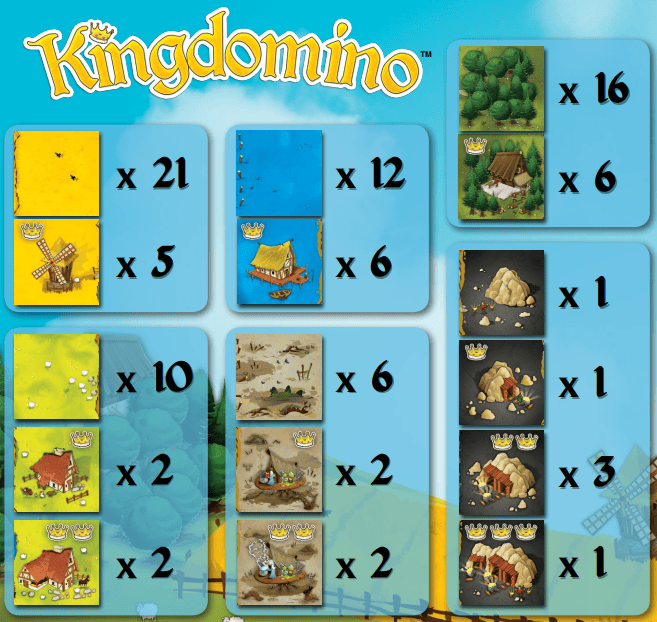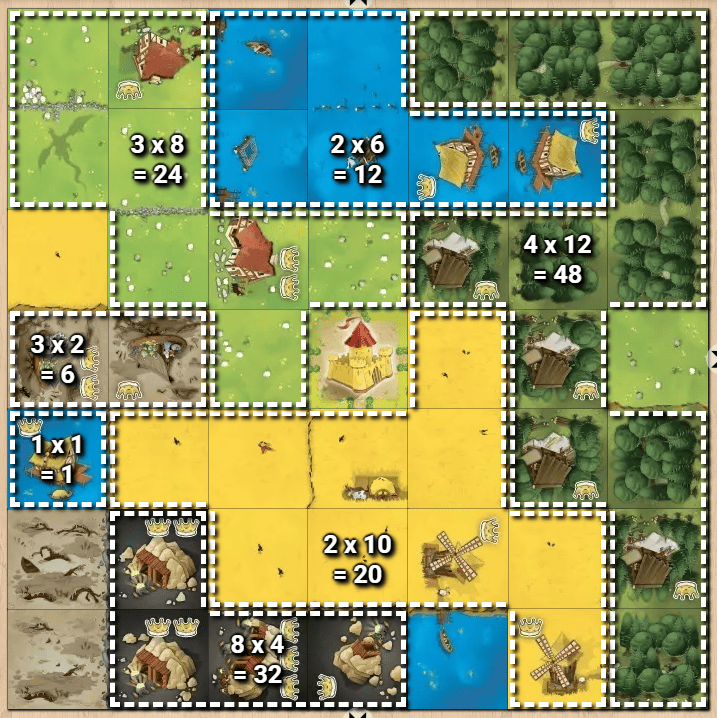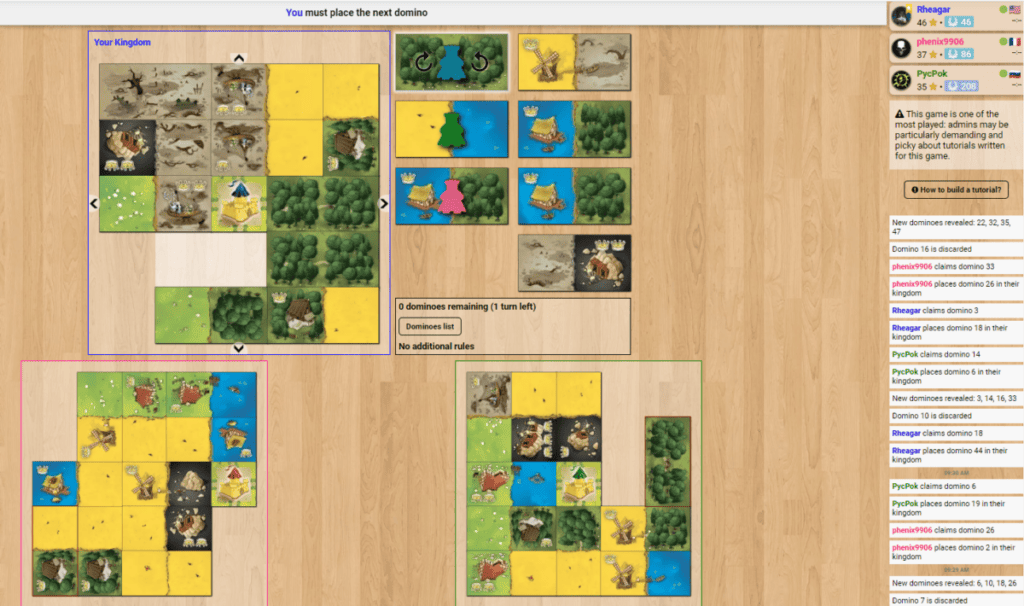
Kingdomino is a modern classic board game that blends simplicity with strategic depth and challenges players to build the most prosperous kingdom. I have been frequently playing Kingdomino online and learned a lot about the game’s strategy both from my own games and those of top players. These Kingdomino strategies will improve your game and help you to win more often.
In general, the best Kingdomino strategies are to focus on scoring big with two or three terrain types, balance claiming crowns with getting the first pick, and segment your board by terrain type. Plan ahead by accounting for the next tile you’ll claim, and deny your opponents the tiles they need.
Kingdomino (link to Amazon) has a fair amount of luck, but by learning a bit about the game and applying the strategies below you’ll win far more often than you lose. I’ll go into why these strategies work (with some light math to back it up) so that you’ll be able to effectively implement them in your own games.
Focus on Fields, Forests, and Lakes to score big

Not all tiles in Kingdomino are created equal. Every terrain type has a different amount of total tiles, and the number of crowns in each type is distributed differently. The game’s instructions point this out, but I find it easier to see in table form:
| Terrain | # of Tiles | # Tiles w/ Crowns | # of Crowns |
|---|---|---|---|
| Forest | 22 | 6 | 6 |
| Lake | 18 | 6 | 6 |
| Field | 26 | 5 | 5 |
| Mountain | 6 | 5 | 10 |
| Swamp | 10 | 4 | 6 |
| Grassland | 14 | 4 | 6 |
Knowing how many tiles and crowns there are of each type is just the beginning. What we’re looking for is value and what tile types are most likely to lead to victory. Well, I studied the data from top players on BGA and discovered that, compared to the average player, they emphasize scoring with Fields, Forests, and Lakes.
I took the percentage of each terrain type (for example, 27% of the total tiles are Fields) and compared it to the percentage of points top players score with that terrain type (for example, top players score an average of 23% of their points from Fields). Then, I compared those results to those of the average player. The results look like this:
| Terrain | Top Player % of Points / % of Tiles | Avg Player % of Points / % of Tiles | Difference |
|---|---|---|---|
| Forest | 109% | 100% | +9% |
| Lake | 97% | 99% | -2% |
| Field | 83% | 72% | +11% |
| Mountain | 191% | 215% | -23% |
| Swamp | 88% | 106% | -18% |
| Grassland | 90% | 99% | -9% |
Pay attention to the ‘Difference’ column. It’s clear that top players prioritize scoring with Forests, Fields, and (to a lesser extent) Lakes while paying less mind to Mountains, Swamps, and Grasslands. Perhaps not surprisingly, the three terrain types that top players focus on are the most common tiles in the game.
It’s not enough to simply claim and place more Forests and Fields – clearly, they must also be strategically placed (more on this later). But the data clearly shows that top players tend to favor Fields, Forests, and Lakes over the other three terrain types, and if you want to improve then you should, too.
Prioritize claiming crowns early, first pick late
One of the most well-known strategies in Kingdomino is to focus on claiming crowns early in the game. The crowns you claim early tend to dictate the type of tiles you will focus on throughout the game, and they lay the foundation of your scoring engine.
In the early phases of the game, things are more flexible. The specific terrain type you choose isn’t overly important because you haven’t locked into terrain types to focus on. Just acquire as many crowns as you can – preferably in just a couple of terrain types.
DID YOU KNOW? Kingdomino has an expansion called Age of Giants, bringing new challenges and player interaction. You can check it out here on Amazon.
As the game progresses, you’ll want to begin specializing in just 2 or 3 terrain types (more on this in a bit). Crowns in those terrain types will become very valuable to you, so you want to get first pick at them when new tiles are drawn. Around the mid-point of the game you should begin to place more emphasis on claiming the first pick and less on acquiring crowns of new terrain types.
It’s worth noting that tiles with 2 or 3 crowns tend to have higher numbers assigned to them, so they tend to be placed near the bottom of the column of tiles. If you ever see a multi-crown tile in any location other than the bottom it’s very good value, so you should definitely try to swoop it up.
Score big in 2 or 3 terrain types
The most successful Kingdomino boards tend to focus on scoring with tiles of just 2 or 3 terrain types. Large, connected swaths of similar tiles are the most efficient way to score points because their tiles can all benefit from the crowns within the territory. This is much more effective than spreading your efforts over many different terrain types.
CHECK IT OUT: If you like strategic tile-laying games, be sure to check out my Complete Strategy Guide to Carcassone
We can demonstrate this point by taking it to the extreme. On a 5×5 playing grid, we have 24 tiles to potentially score with (25 minus the castle square). If we had 24 grassland tiles with a total of 2 crowns, that would score us 48 points. If we had 12 Grassland tiles containing 1 crown and 12 Lake tiles containing 1 crown, that would score only 24 points!
That isn’t to say that you should ignore scoring points with terrain types you’re not focused on. Sometimes the best option available to you will be to pick up some extra points in a terrain type you haven’t been actively building, and that’s fine. But, when presented with the option, always try to build on the large territories you’ve built out.
Adjust your play to the variant you’re playing
Part of what makes Kingdomino so fun and replayable is its many variants. You can play with 2 to 4 players, score bonus points for keeping your castle in the middle of your grid, score bonus points for having a complete grid, and play with twice the normal amount of tiles with two players for more action.
Always make sure you establish what variant/rules you’re playing by before the game starts and adjust your play accordingly. Scoring 10 bonus points for keeping your castle in the middle (The Middle Kingdom variant) can easily be the difference between winning and losing.
Perhaps the biggest adjustment is The Mighty Duel variant where 2 players play with all of the tiles instead of just half. This presents the opportunity to create very large swaths of terrain types and can result in big point swings.
Avoid discarding tiles by keeping options open
It should come as no surprise that discarding tiles isn’t ideal. Every tile you discard is a wasted opportunity to score points. The only time that it might be desirable is if you’re in a tight battle with your opponent and you need to steal a tile that would be a massive help to them but that you can’t play yourself.
Top players very rarely discard tiles. In fact, they only do it about 20% as often as the average player, and it’s almost assuredly in situations like I described above. This is probably because they’re usually comfortably in the lead already and they don’t have to worry about playing defense, but is also likely because they have kept their options open to be able to play a variety of tile types.
You can remain flexible by trying to leave the edges of as many terrain types as possible exposed. You should also try to delay using all of the edges of your castle since you can place any terrain type against each edge of your castle. This gives you a lot of flexibility in the middle of your kingdom and can really help with your tile layout.
Segment your board by tile type
One of the most challenging (and entertaining) aspects of Kingdomino is arranging the tiles in your kingdom. As we’ve discussed, having large and connected swaths of terrain types is critical to success, so the layout of your tiles is paramount.
In general, it’s best to draw tiles in the terrain type(s) you’re focused on and group them together on the board. Drawing a tile with two different terrains you’re interested in is perfect if you can have those terrain types bordering one another. Try to leave the ‘extra’ tiles you’re not focused on on the edge of your kingdom.

Place high-frequency tiles near the middle
Another thing I noticed when reviewing the games of top players is that they tended to place Fields, Forests, and Lakes in the center of their Kingdom. These are the most common tile types and therefore have more opportunities to connect & grow, so it makes sense to keep them near the center of your kingdom and the focus of attention. I started implementing this strategy in my own games and saw immediate benefits.
A by-product of this strategy is that low-frequency tiles like Mountains and Swamps get pushed to the outer edges of your kingdom. This is fine (and often desirable) because they aren’t usually the top priority and since there are fewer tiles of those types there is less of a need for them to have connecting options.
Look for value from both terrain types on a tile
It’s easy to get focused on the side of a tile that contains a crown (or crowns), but don’t forget that each tile has two terrains. Sometimes those terrains are the same type (two forests, for example), but usually they’re different. You should try to get some value out of both sides of each tile in order to score the most points.
You may not be able to connect both sides of a tile to others of their terrain, but look for options where the possibility remains open. You may be able to connect the straggling tile later in the game if you get it close. A few moves like that can be the difference between winning and losing.
Account for the next domino(s) when placing a tile
In that vein, make sure you’re paying attention to the tiles that have been flipped before you place your tile(s). Look for ways your current tile can work in harmony with tile (or tiles) in the next batch. You may be able to place your current tile in a location that doesn’t immediately look very good, but makes a lot of sense when combined with the next tile you’ll claim.
This strategy is particularly useful when you have the first pick since you’ll know for certain that you’ll be able to claim the tile you have your eye on. However, even if you don’t have the first pick, you can still make an informed guess and let the tile options influence where you place your current tile.
Claim tiles that would be good for your opponent

Being competitive in Kingdomino means not letting it become a game of multiplayer solitaire. Near the end of a game, look at your opponent(s) board and try to identify:
- Who is currently winning the game?
- Does your opponent have large patches of the same terrain type that he could easily connect?
- Would crown(s) of a terrain type score him a lot of points?
If your opponent is in a position where a tile or two would score him huge points, you would do well to try to claim those tiles before he does. This is especially true in two-player games, where every point you deny your opponent is as good as one you score for yourself.
Avoid tile orientations that necessitate tile gaps
Having a 1×1 gap in your board is seldom a good idea. This is, of course, especially true for game variants that grant bonuses for complete and symmetrical kingdoms. Do your best to avoid creating 1×1 gaps where no tile can ever be played, because it results in scoring inefficiencies. The bare edges of that 1×1 gap could have been used to connect like terrain types and score more points, but instead, it’s an eyesore that interferes with your scoring.
Don’t let the current score mislead you
The goal of Kingdomino is to have the most points at the end of the game, not to lead for most of the game. This might seem obvious, but it’s an easy trap to fall into – especially in online play where the score is continuously calculated and displayed for all to see.
The score can change drastically on the last turn of the game if a player manages to connect two large sections of the same terrain type or add two crowns to a huge territory. Always play for maximum efficiency and don’t get comfortable. Keep an eye on your opponent’s board so that you’ll recognize any opportunities they have to vault past you in points.
Thanks for reading! If I missed something or you have your own opinions, please drop a comment below.
What is thr benefit of along out first in hand? Seems to me like you would never want to assume…
Your strategy comments are excellent, well thought out and very helpful! Thank you
You would only get to draw and play a Sanctuary card on turn two of round one if the Region…
Rule question. If in phase one of round one I play a Region card with a Clue symbol at the…

Leave a Reply